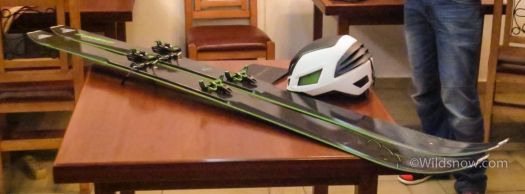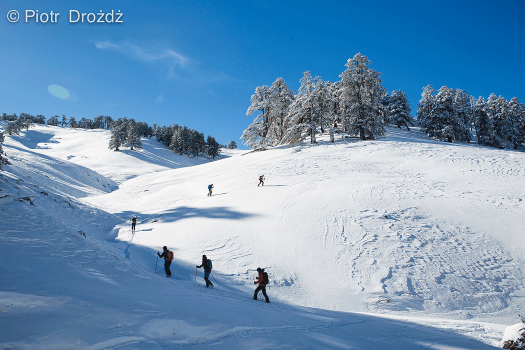We had two good days for ski testing here in Greece. About 6,000 vertical; with varied conditions from powder to winded frozen. Being on the narrowest and shortest plank I’d skied on in years did not initially inspire, but after a few laps I figured out how to stand on the ski and was able to get a good feel for how it worked.
There were a large variety of skis to test the 2016 Dynafit Press event. I was tempted by the new Meteorite, a 97 waist ski with strong, sidewall construction that isn’t the norm for Dynafit. However, I wanted to keep up with the euros, so I settled on the svelt Carbonio 88. I was also anticipating harder snow, and figured a skinnier ski would be a better choice.
Carbonio is Dynafit’s top-of-the-line new ski. In the past the company’s skis have incorporated a few carbon stringers, but have been largely traditional wood-and-fiberglass construction. The Carbonios, in contrast, use quite a bit of carbon, a “full carbon construction” (we continue to research that term) wrapped around a wood core. Also, they use Dynafit’s “micro sidewalls”, which is basically a cap construction with a few mm of sidewall near the edge of the ski.
At a stated 1,100 grams in the 167 length, Carbonio is very light for its size, and also quite stiff (something I like in a shorter, skinnier ski mountaineering ski). The Carbonio is a fairly traditional shaped ski, with very slight rocker in the tip and tail, and also a bit of a longer tip and tail taper, much like other Dynafit skis. The skis also incorporate the standard Dynafit “dual radius” sidecut, with a turn radius of 15.7/15.1.
Is two days of touring enough for a ski test? Perhaps not if you’re out skiing perfect pow like I was doing in Colorado just a few days ago. However, I encountered a variety of conditions here in Greece, including breakable crust, slush, wind-scoured ice, windboard, and powder (at least something was nice). Also, compared to a typical demo involving only a few runs on a ski area, I managed to get a good feel for how it worked over two days of ski touring with about 7,000 vertical feet of turns.
Test size was 167. I haven’t skied on a ski that short since middle school. The first day of touring, we skied slushy breakable crust (yeah, that good), and I found the skis difficult to ski, mostly because of their length and width. I kept breaking through the crust with the tails.
The next day, on our climb Mt. Smolikas, the skis felt much better. The low weight was awesome on the skin up. We had to run up to the summit to beat some oncoming weather, and the light weight was a welcome advantage. The upper part of the ski was was low-angled rock hard wind-scoured snow, which made for surprisingly fun skiing. I was able to rip fairly fast, big turns with the skis, despite their short length and small turn radius.
A bit down from the summit, we encountered steeper terrain, with similarly hard snow. The skis had a bit of chatter at high speed, but once I backed off a bit they skied quite well. We also encountered some wind packed heavy snow, and the slight tip rocker handled it nicely. Lower down, we encountered excellent Hellenic powder in the lower trees. The Carbonios felt great in the pow as well (what doesn’t), despite them definitely not being a powder ski.
Although this was a somewhat short test, I got a good feel for how the Carbonios ski. In my opinion they would be a fine choice in the light, skinny ski mountaineering category, although they still have a bit of width and rocker to handle variable snow conditions. They are turny, especially the short length that I tested. They would be an ideal ski for spring skiing in the PNW, although I might go with the next size up.
Louie Dawson earned his Bachelor Degree in Industrial Design from Western Washington University in 2014. When he’s not skiing Mount Baker or somewhere equally as snowy, he’s thinking about new products to make ski mountaineering more fun and safe.


